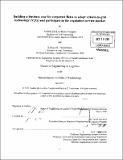Building a business case for corporate fleets to adopt vehicle-to-grid technology (V2G) and participate in the regulation service market
Author(s)
De los Ríos Vergara, Andrés; Nordstrom, Kristen E
DownloadFull printable version (17.46Mb)
Other Contributors
Massachusetts Institute of Technology. Engineering Systems Division.
Advisor
Jarrod Goentzel.
Terms of use
Metadata
Show full item recordAbstract
Electric (EV) and Plug-in Hybrid Electric vehicles (PHEV) continue to gain attention and market share, not only as options for consumers but also for corporate fleets. EVs and PHEVs can contribute to lower operating costs through reduced maintenance requirements and enhanced fuel economy. In addition, a fleet of EVs or PHEVs, when parked and aggregated in a sizeable number, can provide regulation services to the grid through the electricity stored in the vehicle's batteries. This opportunity is known as Vehicle-to-grid technology (V2G). This thesis evaluates the economics for V2G-enabled fleets to participate in the regulation services market. In order to build a business case for fleet managers, we constructed a 10-year cash flow model that compares the operating, infrastructure, and capital costs, as well as the revenue opportunities for EVs, PHEVs, and ICEs. To quantify potential revenues, we adapted a tool that the ISO New England has used to simulate the revenues of participants in the regulation market for an alternative energy pilot. We show that ICEs, while having the lowest retail value, actually have the greatest NPV due to their high operating costs and inability to participate in the regulation services market. EVs have the highest retail value, but due to their large battery size are able to provide the most regulation services. The opportunity for V2G is critical for the attractiveness of the EV. PHEVs offer lower V2G revenue opportunity than the EVs but have greater operational flexibility. We determined that V2G revenue potential is driven by the charger capacity and battery size and there are tradeoffs associated with these components. A larger battery and charger will generate more money from regulation services, but their high investment cost may outweigh these benefits. The correct combination of charger capacity, battery size, and state of charge (SOC) is important. If the charger capacity is too large and SOC too high or low, a small battery can be charged or depleted too quickly, hindering its ability to provide regulation services.
Description
Thesis (M. Eng. in Logistics)--Massachusetts Institute of Technology, Engineering Systems Division, 2011. Cataloged from PDF version of thesis. Includes bibliographical references (p. 95-98).
Date issued
2011Department
Massachusetts Institute of Technology. Engineering Systems DivisionPublisher
Massachusetts Institute of Technology
Keywords
Engineering Systems Division.